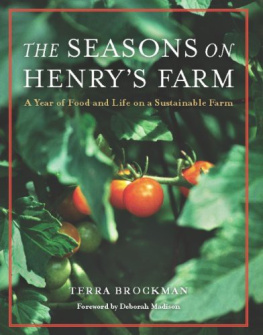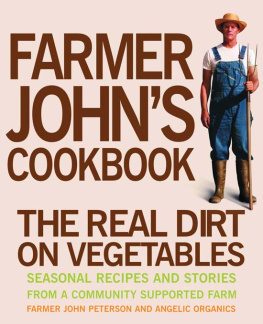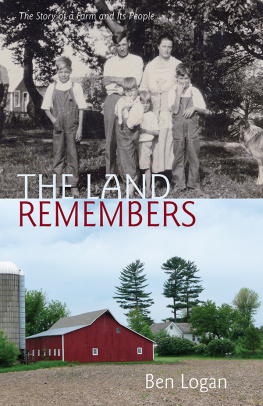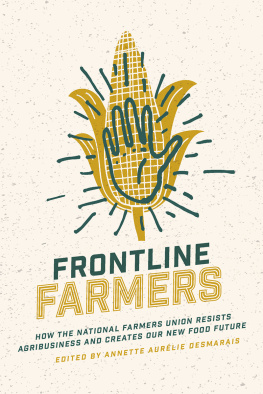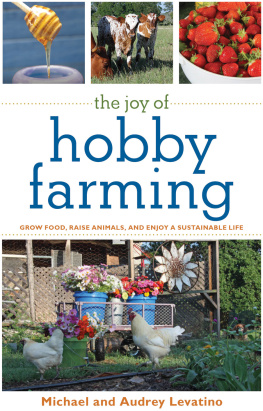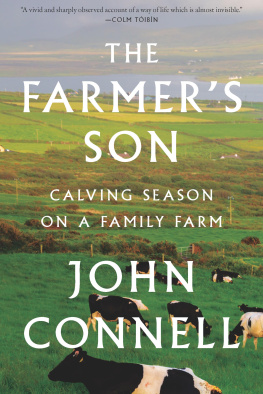Table of Contents
For Marlene and Herman, who instilled a love of family, nature, food, farming, thinking, writing, and fighting the good fight to make this earth a better place for those who will come after us.
And for Henry, without whom there would be no Henrys Farm, and no The Seasons on Henrys Farm.
And for all my other siblings, nieces, nephews, and in-laws, who enrich my life in more ways than I can say.
ACKNOWLEDGMENTS
I want to thank the following:
Henry Brockman, Herman Brockman, Zoe Brockman, Teresa Santiago, and Gabriela Santiago, for the use of excerpts of their writings.
Sandra Steingraber, for scientific and writerly rigor, inspiration, and advice, and for Midwestern caring and keeping in touch.
Scott Sanders and all the Sanderlings at Wildbranch who read my early attempts and helped launch this project.
Deborah Madison, for walking the fertile earth of the flyover states and writing the foreword.
Yoji Yamaguchi, who reappeared in my life at exactly the right time and was always there with honest words and practical assistance when I needed them most.
Hiroko Kinoshita, for her beautiful endpapers and chapter heading illustrations.
Glenda Kapsalis, for generously donating the cover photograph of Henrys Sungold tomatoes.
Rene Mullen, Ginny Lee, Glenda Kapsalis, and Edible Chicago for providing wonderful photos to illustrate life and work on Henrys Farm.
Doug Seibold and all the good folks at Agate, for putting up with my delays and obsessions, and for recognizing, and in the end accepting, that I am a putter-inner, not a taker-outer.
Joel Smith, for feeding me in more ways than one, and making this and so much more possible.
If I got things wrong in here, and Im sure I did, the fault is wholly my own.
FOREWORD
by Deborah Madison
W HILE TOURING FOR MY BOOK ON AMERICAS FARMERS MARKETS, Local Flavors , I returned to the heartlandotherwise known (and sadly so) as the flyover stateswhere I had visited many fine markets. Thats how I found myself at a crossroads in Illinois, with endless cornfields on one side, barren land on the other, and a small sign that read Henrys Farm by the side of the road. Nothing about the simple sign hinted at the entanglement of complexity that makes up the fabric of what Ive come to think of as the enormous life of a small farm.
When I finally did get to Henrys Farm, the land dipped, the road curved and sloped under overhanging trees, and row upon row of flourishing crops emerged, quietly tended by a crew of family and workers. The flatlands were gone. Texture had appeared, and I can still savor the bright tastes of the simple lunch I enjoyed with two of Henrys sisters, Teresa Santiago, who grows fruits and herbs a few miles away, and Terra Brockman. Since that visit, I have continued to follow the life of Henrys farm through Terra and Teresas weekly e-newsletter, which has taught me and more than a thousand others not only about the vagaries of farm life and its perennial dance with weather but also about farming itselfabout soil, water, varieties, and the multitude of interrelated factors that determine how good food comes to us.
Terra Brockman helps farm the familys land, so her story comes deeply out of herand the farmslife. The Seasons on Henrys Farm , a book to be reckoned with, lifts you high enough to witness the tremendous possibilities people are capable of expressing in their working livesin this case, through farming. If youre a fan of Aldo Leopold, or have long suspected that time-honored methods of farming are best for the earth (and our taste buds) and require intelligence and thoroughness exceeding the levels demanded by most occupations, you will discover here that your suspicions are well founded.
The landscape of Henrys Farm is further revealed in the things that grow out of itsuch as this sturdy fennel bulb, full of earthy sweetness.
Although Terra Brockman seldom uses the word sustainability, The Seasons on Henrys Farm tells the story of what it looks like when a farm and its family come as close as they can to living a sustainable life. Real sustainability is a complex thing. Its big and minute at the same time. Its hidden but also obvious. It depends on stamina and ingenuity in lieu of fossil fuels. It tests everything and is a tough master. Nothing is concealed in this kind of farming. Its all thereambitions and hopes, beauty and forgetfulness, and sometimes painful steps to ensure a harvest. (Henry is forever working extra hours at the end of the day, to the point where you want to scream at the pages, Henry, go have supper! But its work that has to be done.)
The Seasons on Henrys Farm is an exhilarating story of observation. Its a humbling one, too, for few of us can imagine mustering the endurance and precision needed to farm this deeply. But that Henry and his familial band of followers can and do, again and again, makes the world of the farm more than a dream or an ideal. Its a great encouraging kick in the pants for all of us, regardless of how we spend our time or what we do, to achieve such excellence in full consciousness of all its complexities and consequences. This book tells a tale as raw and vivid as one could hope for, while gently imparting what we need to know about the soil, plants, and animals that sustain us.
Finally, it is a relief to enter a world where the seasons are not just four of equal duration but are supple times aligned to accommodate ones work and natures rhythmssay the two-week season for planting garlic in November or the few-days-long season for mulching it over the first icy crust of December. The broad strokes so often used to paint lifes portrait have their use perhaps, but they cant capture the fine lines, shadings, and shadows that emerge from the keen knowledge of the whole of our world and all of its seasons.
Terra Brockman has made an enormous painting rendered in the finest detail. The Seasons on Henrys Farm hints at what and who we need to be in order to live in concert with the world we wish to know most deeply. The greatest possibilities of human life are expressed not on those flat crossroads where the sign to the farm stands but in the irregular world of slopes and curvesa world of many seasons, and not just four.
Deborah Madison
INTRODUCTION
T HIS BOOK, IN THE BAREST TERMS, IS ABOUT 52 WEEKS OF LIFE ON A diverse, sustainable farm in central Illinois. Its the place where I grew up, and the place I couldnt wait to leave.
And leave I didfirst to the West Coast and then on to Japan for five years and New York City for ten. But I come from four generations of Illinois farmers on my fathers side and untold generations of landless peasants in southern Italy on my mothers side. So the gravitational forces exerted by a patch of fertile earth were hard to resist.
Central Illinois is where my paternal grandparents were born and farmed and where my mother and father and half of my siblings now live. I have three sisters, all younger (Beth, Teresa, and Jill) and two brothers, one older (Fred) and one younger (Henry). Jill lives on the farm where my grandfather and father were born; Teresa raises more than 70 varieties of fruits and dozens of herbs near Walnut Creek in the small town of Eureka; and Henry grows more than 650 varieties of vegetables on 10 acres bordered by Kinder Creek and Walnut Creek, just a few miles downstream from Teresa.

